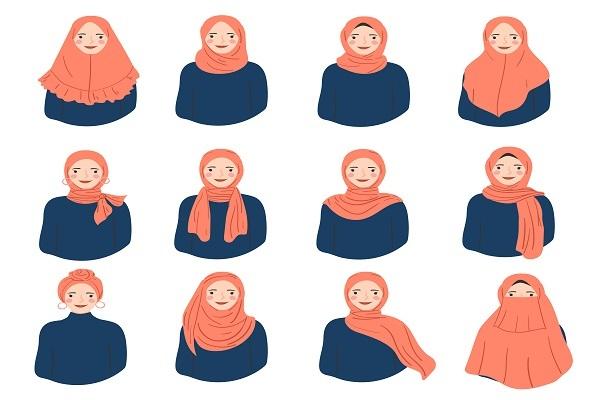Many know the costume used by Muslim women called hijab. But what is not widely known is why they dress like that and what rules are imposed.
O use of the hijab dates back to Islam's most important prophet, Mohammed (Muhammad). He would have asked his wives to wear the item to differentiate him from others. The intention was to show their status, considered special.
The nomenclature hijab refers to the type of coverage used by most of these women. Normally, their hair, neck and shoulders are covered by means of a scarf or shawl.
Contrary to what most people think, are not all muslim women what use hijab.
In some places, such as in Saudi Arabia, in the Islamic Republic of Iran and in the province of Aceh, in Indonesia, use is required by law.
However, in most places, it is more a matter of custom, with women choosing to wear a hijab. Most of the time, they decide whether to wear a hijab in their teens.
It all depends a lot on the school of Islamic thought in which the person is inserted. There may be an obligation to wear a burqa, as in the case of
Taliban Afghan, or just wearing a veil, as in Türkiye.Some countries, both in Europe and in the Muslim world, have passed laws banning the headscarf in public. or in certain types of locations.
Also access:Taliban and the Resumption of Power in Afghanistan
Topics of this article
- 1 - Why do Muslim women wear the hijab?
- 2 - Islam and the hijab
- 3 - Types of veils worn by Muslim women
Why do Muslim women wear the hijab?
It is not new that women in different parts of the world are under pressure for whether or not to wear a headscarf. They choose to wear the hijab for various reasons. See some of them below:
they see it as a sign of passage into adulthood;
in order to identify themselves as Muslim and show cultural pride;
to enhance family traditions or local customs.
Some Muslim women choose not to wear the hijab and others choose to wear it only on religious occasions.
There is prejudice about wearing the hijab, as many people outside of Islam misinterpret it as they believe Muslim women are forced to wear it.
There are still those who call for it to be banned from culture. For these people, women do not wear the veil by choice, often being forced to cover their heads and bodies.
However, many daughters of Muslim immigrants in the West justify that the headscarf symbolizes devotion and piety and that its use, for them, is their own choice, a matter of religious identity and self-expression.
As more people learn about the hijab and Islam, there is greater acceptance and understanding of the garment.
It is noteworthy that, even today, headscarves play a significant role in many religions, such as Judaism orthodox and the Catholicism.
Islam and the hijab
O Islam has grown to become one of the major religions in the world. With this growth, it ended up spreading across the Middle East, to the Africa of sahara and Sub-Saharan Africa, for the Asia Central and to different regions around the Arabian Sea.
Do not stop now... There's more after the publicity ;)
Some local customs were also incorporated and exerted influence on other populations. But the demand by some Islamic states, such as Iran, that all women wear a headscarf is recent.
The holy book of Muslims, the Qur'an, reads as follows in 33:59:
O prophet, tell your wives, your daughters and the wives of the believers that when they go out, they cover themselves with their blankets; this is more convenient, so that they are distinguished from the rest and are not disturbed.
Therefore, the religion define it as a conduct that these people have to follow, to conform to religious practices.
Read more:Difference between Arabs and Muslims
Types of veils worn by Muslim women

hijab
O hijab and the more popular of the veils, which usually covers only the hair, ears and neck. It leaves the face and much of the body outside, and can be found in the most varied forms. It can be colored, printed or even decorated, depending only on the taste and preference of who is using it.
There are also different ways to tie the hijab. Some of them are made by women of certain countries or regions and receive proper names.
chador
In addition to the hijab, there is also the chador, which usually covers the entire body of the woman and has no sleeves, leaving only part of the face exposed. Most of the time, it is in black, but it can also be found in other colors, prints and with different decorations. It is very traditional in Iran, but after the Islamic Revolution, which took place in the late 1970s, it became popular elsewhere.
niaq
Niaq generally covers the entire body, leaving only the person's eyes visible. Even though it is usually all black, it is also seen in other colorations. In countries like Saudi Arabia, the law states that women must wear this garment. There is also a version of the niaq in which part of the body is exposed.
burqa
The burqa (or burqa) is the veil that covers most of the body and face. It prevents the visibility that people have of the woman, and there is a screen that covers the eyes. It is most commonly found in blue or black. In the regions of Afghanistan and Pakistan, when under Taliban rule, have already decreed that their use should be mandatory.
image credits
[1] Mohasseyn / Shutterstock
By Erica Caetano
Journalist
Click and learn more about Islam, the second largest religion on the planet. Understand the origins of this religion and learn about its principles and five pillars.
Click on the link to learn about the life of Malala Yousafzai, Pakistani activist. Understand why she became a target of the Taliban. Find out what she does now.
Learn more details about the life of Muhammad, also called Muhammad. Learn about his personal life and role as a prophet of Islam.
The main religious rituals of Islam.
Click on the link and understand what Ramadan is. Find out how the Islamic custom of fasting in this holy month works and what this practice means.



